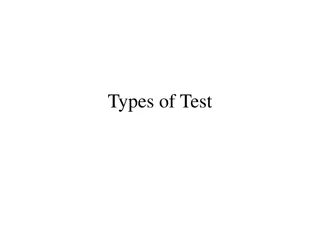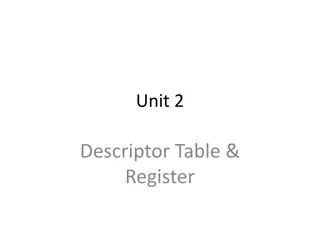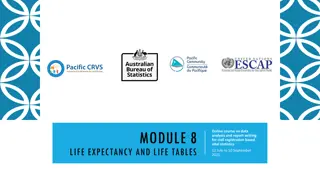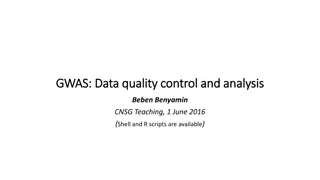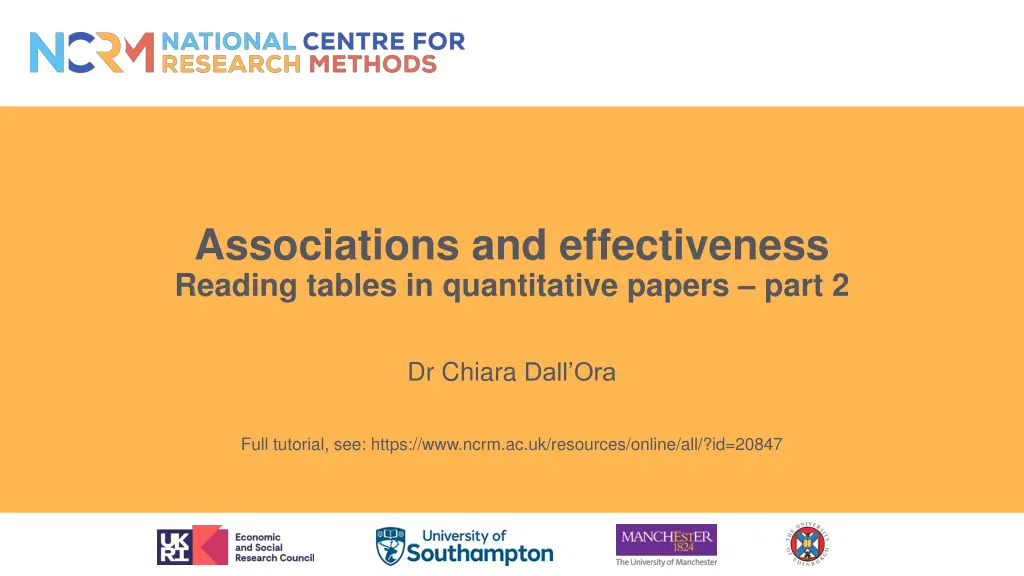
Reading Tables for Associations and Effectiveness in Quantitative Research
Enhance your skills in reading tables that report associations and effectiveness in quantitative papers. Learn to interpret results and understand measures of association and causation. Dive into examples exploring the relationship between college students' personality traits and their willingness to use AI for writing essays, as well as the association between parents' socioeconomic class and students' school enjoyment.
Download Presentation

Please find below an Image/Link to download the presentation.
The content on the website is provided AS IS for your information and personal use only. It may not be sold, licensed, or shared on other websites without obtaining consent from the author. If you encounter any issues during the download, it is possible that the publisher has removed the file from their server.
You are allowed to download the files provided on this website for personal or commercial use, subject to the condition that they are used lawfully. All files are the property of their respective owners.
The content on the website is provided AS IS for your information and personal use only. It may not be sold, licensed, or shared on other websites without obtaining consent from the author.
E N D
Presentation Transcript
Associations and effectiveness Reading tables in quantitative papers part 2 Dr Chiara Dall Ora Full tutorial, see: https://www.ncrm.ac.uk/resources/online/all/?id=20847
At the end of this resource you will be able to Read tables reporting associations between variable(s) and outcome(s) Read tables reporting measures of effectiveness of an intervention Interpret results from tables
Measures of association Association causation Typical of observational studies Predict the value of the outcome variable for any given value of the predictor
An example Research Question: What is the association between college students personality traits and their willingness to use AI to write their essays? B SE p Neuroticism 0.27 0.05 0.21 .001 Extraversion -0.61 0.13 -0.52 .001 Openness to experience -0.03 0.00 -0.09 .001 Agreeableness 0.25 0.06 0.10 .001
An example Research Question: What is the association between college students personality traits and their willingness to use AI to write their essays? B SE p Neuroticism 0.27 0.05 0.21 .001 Extraversion -0.61 0.13 -0.52 .001 Openness to experience -0.03 0.00 -0.09 .001 Agreeableness 0.25 0.06 0.10 .001
Research Question: What is the Association between parents socio-economic class and students school enjoyment? OR 95% CI p Higher managerial (reference category) Intermediate Lower managerial Lower supervisory and technical 1.29 0.97 0.98 1.23-1.35 0.94-0.99 0.09-1.23 .0001 .0001 .34
Research Question: What is the Association between parents socio-economic class and students school enjoyment? OR 95% CI p Higher managerial (reference category) Intermediate Lower managerial Lower supervisory and technical 1.29 0.97 0.98 1.23-1.35 0.94-0.99 0.09-1.23 .0001 .0001 .34
Research Question: What is the Association between parents socio-economic class and students school enjoyment? OR 95% CI p Higher managerial (reference category) Intermediate Lower managerial Lower supervisory and technical 1.29 0.97 0.98 1.23-1.35 0.94-0.99 0.09-1.23 .0001 .0001 .34
Controlling for more variables? Univariable associations OR Full model* OR 95% CI p 95% CI p Higher managerial (reference category) Intermediate 1.29 1.23-1.35 .0001 1.11 1.06-1.28 .001 Lower managerial 0.97 0.94-0.99 .0001 1.01 1.01 1.05 .001 Lower supervisory and technical 0.98 0.95-1.23 .34 0.93 0.89 1.12 .20 * Adjusted for age, gender, quality of peer relations on a scale ranging from 1 poor to 4 excellent )
Controlling for more variables? Univariable associations OR Full model* OR 95% CI p 95% CI p Higher managerial (reference category) Intermediate 1.29 1.23-1.35 .0001 1.11 1.06-1.28 .001 Lower managerial 0.97 0.62-0.80 .0001 1.01 1.01 1.05 .001 Lower supervisory and technical 0.98 0.95-1.23 .34 0.93 0.89 1.12 .20 * Adjusted for age, gender, quality of peer relations on a scale ranging from 1 poor to 4 excellent )
A note on absolute risk vs relative risk The OR is a measure of relative risk, but to interpret it absolute risk is important, too. 29% increase in the likelihood of the outcome? Check cross-tabs/descriptive data when interpreting results
Measures of effectiveness Typically from experimental studies Effect size The focus is on the magnitude of the effect of the intervention/experimental treatment
Measures of effectiveness Research question: What is the effect of a life coach intervention on quality of life of patients who have been diagnosed with cancer?
Measures of effectiveness Research question: What is the effect of a life coach intervention on quality of life of patients who have been diagnosed with cancer? Mean (SD) Intervention group (life coaching post cancer diagnosis) Control group (standard care) T0 T1 T2 T0 T1 T2 p n=772 n=768 n=749 n=791 n=785 n=771 Quality of life* Physical .01 62.6 (11.1) 63.9 (9.8) 64.2 (9.1) 63.1 (9.9) 63.7 (8.4) 64.1 (8.5) Psychological .01 59.1 (12.3) 60.1 (11.4) 60.2 (12.8) 59.3 (6.8) 60.0 (8.7) 60.1 (9.1) Social relations .21 63.6 (15.8) 64.9 (10.9) 67.7 (14.3) 63.5 (14.7) 64.9 (9.2) 67.8 (8.9) * Adjusted for age, gender, ethnicity, socioeconomic status, job status (unemployed/employed/retired/semi- retired)
Measures of effectiveness Research question: What is the effect of a life coach intervention on quality of life of patients who have been diagnosed with cancer? Mean (SD) Intervention group (life coaching post cancer diagnosis) Control group (standard care) T0 T1 T2 T0 T1 T2 p n=772 n=768 n=749 n=791 n=785 n=771 Quality of life* Physical .01 62.6 (11.1) 63.9 (9.8) 64.2 (9.1) 63.1 (9.9) 63.7 (8.4) 64.1 (8.5) Psychological .01 59.1 (12.3) 60.1 (11.4) 60.2 (12.8) 59.3 (6.8) 60.0 (8.7) 60.1 (9.1) Social relations .21 63.6 (15.8) 64.9 (10.9) 67.7 (14.3) 63.5 (14.7) 64.9 (9.2) 67.8 (8.9) * Adjusted for age, gender, ethnicity, socioeconomic status, job status (unemployed/employed/retired/semi- retired)
Final remarks Statistical significance clinical significance Is effectiveness of an intervention enough to recommend upscale and implementation?






